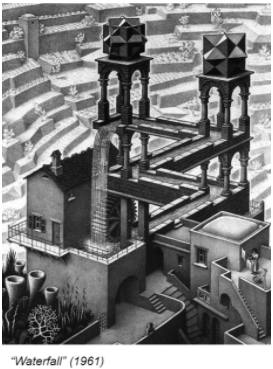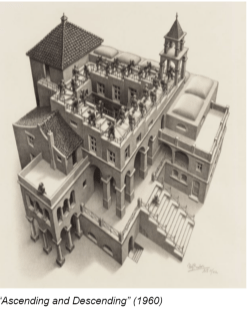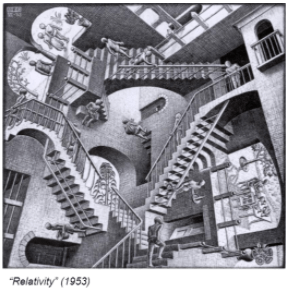M.C Escher: Master of Illusions
Written by Sharon Chen
 MC Escher, or Maurits Cornelis Escher, is a Dutch graphic artist that specializes in realistic yet impossible prints. His artworks are commonly seen in designs everywhere in modern graphics and illusions. The majority of his works consists of printmaking and woodcutting.
MC Escher, or Maurits Cornelis Escher, is a Dutch graphic artist that specializes in realistic yet impossible prints. His artworks are commonly seen in designs everywhere in modern graphics and illusions. The majority of his works consists of printmaking and woodcutting.
His works can be seen everywhere, inspiring countless posters, games, designs, movies, etc. For example, the popular indie game, Monument Valley, was heavily inspired by his works. A scene from the 1968 movie “Labyrinth” was also inspired by Escher’s piece “Relativity”. Yet despite all the popular appearances of his art, he was never really recognized by the art world.
Escher’s story starts in Leeuwarden, Netherlands. He was born there in 1898. He was very creative as a child, and was also influenced by
his father from an early age, who was an engineer. Starting from 1922, his parents sent him to school for architecture. It was there he met his teacher Samuel Jessurun de Mesquita, who inspired him to dive into the world of Graphic Arts. He gave up architecture and began studying drawing and linocuts. After completing school, he began travelling through Europe, in which he spent a long time living in Italy. He stated several times through his letters to friends how much he loved Italy, and it can be evidently seen through the Italian-inspired architecture found in many of his artworks. He also met his wife, Jetta Umiker, in Italy as well. He lived with his wife and two children there for over a decade, creating hundreds of pieces based on his observations and the beautiful architecture there. Later, political turmoil led to the family moving away. After living in a few other countries, they finally returned to Switzerland and Escher settled down there for the remainder of his life. He gradually grew in fame during the last couple of decades of his life. However, his health deteriorated and he also grew more and more distant from his family. Escher passed away in 1972. He created over 400 woodcuts and lithographs, and over 2000 sketches throughout his lifetime.
Escher lived through both World Wars, and though his relatively good family background protected him from experiencing too much danger, he was still heavily impacted by the effects of war. Several of his closest Jewish friends, along with his beloved teacher de Mesquita, were killed by the Nazis during World War II. This left Escher depressed and feeling pessimistic about humanity, many of his works starting to focus less on reality and more on the imaginative world.
 “Ascending and Descending” is a piece created by Escher in 1960. This piece has a crowd of people walking on a set of staircases at the top of the building. However, though the people are constantly walking forwards on the stairs, they simply circle over and over again, reaching nowhere. The stairs that lead to nowhere are often interpreted as a metaphor for the futility of life. The stairs are also sometimes interpreted as a cycle of human war and history repeating, clearly showing Escher’s view on the war and pessimism about humanity. However, in the drawing, two figures do not participate in the cycle. Years later, during an interview with Escher, he said “I’m not sure what to do with reality, my work has nothing to do with it. I know it’s wrong. I know it is your duty to help, to help it all turn
“Ascending and Descending” is a piece created by Escher in 1960. This piece has a crowd of people walking on a set of staircases at the top of the building. However, though the people are constantly walking forwards on the stairs, they simply circle over and over again, reaching nowhere. The stairs that lead to nowhere are often interpreted as a metaphor for the futility of life. The stairs are also sometimes interpreted as a cycle of human war and history repeating, clearly showing Escher’s view on the war and pessimism about humanity. However, in the drawing, two figures do not participate in the cycle. Years later, during an interview with Escher, he said “I’m not sure what to do with reality, my work has nothing to do with it. I know it’s wrong. I know it is your duty to help, to help it all turn
for the better. But I am not interested in humanity.” In many of his works, there are often one or two lone figures that stick out. Echer projects himself into his art pieces, showing his own confusion about reality and his feelings of isolation and distance from the rest of people
Escher suffered from anxiety to begin with, and only grew more reclusive as time went on. Escher has an irritable temper, often locking himself up for days in order to draw. He gets angry at anyone interrupting his work, gradually distancing himself from his family. As evident in his works, Escher disliked doing portraits, his anxiety making it difficult for him to have people pose in front of him for hours. The only portraits he created were of himself and his wife.
 One of Escher’s most well-known works is “Relativity”. It was created in 1953, and it is a lithograph. This piece was part of his Impossible Constructions collection. The picture consists of an impossible room, with stairs and walls that seem to exist on different planes, gravities, and realities. The figures in the drawing are all faceless and immersed in their own worlds. Escher’s “Relativity” reflects the possibility of various existing planes and questions our reality.
One of Escher’s most well-known works is “Relativity”. It was created in 1953, and it is a lithograph. This piece was part of his Impossible Constructions collection. The picture consists of an impossible room, with stairs and walls that seem to exist on different planes, gravities, and realities. The figures in the drawing are all faceless and immersed in their own worlds. Escher’s “Relativity” reflects the possibility of various existing planes and questions our reality.
Though Escher’s pieces are often associated with Surrealism or Optical Art, Escher does not associate himself with any movement. He helped
with the development of Op Art, but once when asked about it, he rejected association with it by saying, “There are young people who constantly come to tell me: you, too, are making Op Art. I haven’t the slightest idea what that is, Op Art. I’ve been doing this work for thirty years now”.
However, despite Escher’s works and influences on popular culture, he is still very neglected, and many artists still dismiss his work as simple graphic designs and not true art. One reason is that he often insists that his work holds no meaning, therefore lacking the emotion many artists deem necessary for a “good” art piece. Another reason is his use of mathematics. Escher uses mathematics and science in his designs, which arouses skepticism in many artists. Science/math and creative art were often viewed as two exclusive groups, not believed to overlap much at all. As a result, his works are often dismissed by the art world.
Escher’s work with interesting perspective, impossible spaces, and illusions still awes people all over the world till this day. However, due to the rejection from the art community and constant reprinting and redesigns despite copyright, his work gradually became common enough where people don’t consider the artist behind it. Even so, his influence on popular culture is undeniable, and his works will still remain scattered throughout it indefinitely. His fascinating take on reality and illusions continue to leave a deep impression and fascinate people.